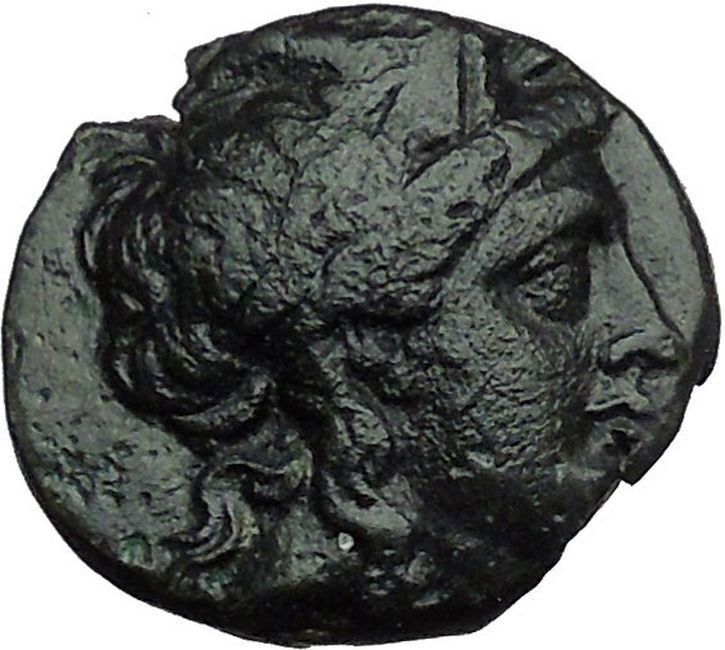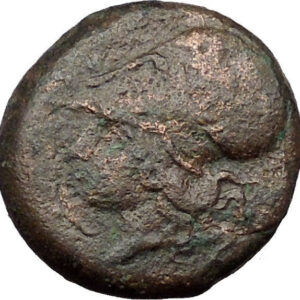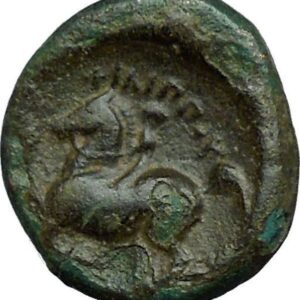|
Greek coin of the Kingdom of Macedonia
Kassander – Regent: 317-306 B.C. & King: 306-297 B.C.
Bronze 17mm (2.95 grams) Struck circa 301-294 B.C. at a mint in Caria
Reference: HGC 3, 999 Rare R1; SNG Munchen 1035
Chalkidian helmet left.
BAΣΙΛΕΩΣ KAΣΣAΝΔΡΟΥ, spearhead.
Kassander, son of Antipater. His father, on his death-bed (B.C. 319), appointed Polysperchon regent, and conferred upon Kassander only the secondary dignity of Chiliarch (cavalry commander). Being dissatisfied with this arrangement, Kassander strengthened himself by an alliance with Ptolemy and Antigonos, and entered into war with Polysperchon. In 318 B.C., Kassander obtained possession of Athens and most of the cities in the south of Greece. In 317 he was recalled to Macedonia to oppose Olympias (mother of Alexander III, the Great). He kept her besieged in Pydna throughout the winter of 317, and on her surrender in the spring of the ensuing year, he put her to death. The way now seemed open to him to the throne of Macedonia. He placed Roxana (wife of Alexander III, the Great) and her young son, Alexander (IV) Aegus (son of Alexander III, the Great), in custody at Amphipolis, not thinking it safe as yet to murder them; and he connected himself with the regal family by marriage with Thessalonica, half-sister of Alexander the Great. He founded the city of Thessalonica in her honor in 315. In 315 Kassander joined Seleukos I, Ptolemy I, and Lysimachos in their war against Antigonos I, Monophthalmus, of whose power they had all become jealous. This was was upon the whole unfavorable to Kassander, who lost most of the cities in Greece. By the general peace of 311, it was provided that Kassander was to retain his authority in Europe until Alexander Aegus should be grown to manhood. Kassander thereupon put to death the young king and his mother Roxana. In 310 the war was renewed, and Heracles, the son of Alexander III by his mistress Barsine, was brought forward by Polysperchon as a claimant to the Macedonian throne; but Kassander bribed Polysperchon to murder the young prince and his mother in 309. In 306 Kassander took the title of king, when it was assumed by Antigonos I, Lysimachos, and Ptolemy I. In the following years, Demetrios Poliorketes, the son of Antigonos I, carried on the war in Greece with great success against Kassander; but in 302 Demetrios was obliged to pass into Asia, to support his father; and next year, 301, the decisive battle of Ipsus was fought, in which Antigonos I and Demetrios were defeated, and the former slain, and which gave Kassander Macedonia and Greece. Kassander died of dropsy in 297, and was succeed by his son Philip IV.
You are bidding on the exact item pictured, provided with a Certificate of Authenticity and Lifetime Guarantee of Authenticity.
 A Chalcidian helmet or Chalcidian type helmet was a helmet made of bronze and worn by ancient warriors of the Hellenic world, especially popular in Greece in the fifth and fourth centuries BC. The helmet was also worn extensively in the Greek (southern) parts of Italy in the same period. A Chalcidian helmet or Chalcidian type helmet was a helmet made of bronze and worn by ancient warriors of the Hellenic world, especially popular in Greece in the fifth and fourth centuries BC. The helmet was also worn extensively in the Greek (southern) parts of Italy in the same period.
Terminology
The helmet is so-called because it was first, and is most commonly, depicted on pottery once thought to derive from the Euboean city of Chalcis. In fact, it is not known whether the helmet originated in Chalcis; indeed, it is not even known whether the pottery in question was Chalcidian.
Description
The helmet appears to have been a development of the Corinthian helmet, its improvements in design giving the wearer better hearing and vision, resulting in a lighter and less bulky helmet.
It consisted of a hemispherical dome, and below that, generally inset from the top dome, a pair of cheek pieces and a neck guard, with a substantial loop on either side for the wearer’s ears. In the front, between the two cheek pieces, was a small nasal bar to protect the wearer’s nose. The helmet could be entirely one piece, or the cheek pieces could be attached separately by hinges, which eased construction and made putting the helmet on easier. In Italy, the helmet with fixed cheek pieces is referred to as Chalcidian, its variant with hinged cheek pieces is called a Lucanian helmet because it was widely used in Lucania.
The helmet would commonly have a hole pierced on each cheek piece or elsewhere in order to accept an inner lining which was made of leather. Adornments such as combs and other protuberances were usually placed on the top of the helmet.
Usage
By the time of Alexander the Great, the helmet was still worn by armoured soldiers, especially Hoplites, the spear-armed heavy infantrymen (other than those of the Spartans, who instead wore the much plainer pilos helmet). It is likely that some of the Macedonian soldiers who ruled the rest of Greece and went on to forge a substantial Hellenistic empire also wore the Chalcidian helmet. The helmet is thought to have developed in turn into the Attic helmet which is iconic of classical soldiers.
Kassander, King of Macedonia (305 – 297 BC), was a son of Antipater, and founder of the Antipatrid dynasty.
Cassander is first recorded as arriving at Alexander the Great’s court in Babylon in 323 BC, where he had been sent by his father, Antipater, likely to help uphold Antipater’s regency in Macedon, although a later contemporary suggestion hostile to the Antipatrids was that Cassander had journeyed to poison the King.
Whatever the truth of this suggestion, Cassander certainly proved to be singularly noted amongst the diadochi in his hostility to Alexander’s memory. Alexander IV, Roxanne, and Alexander’s supposed illegitimate son Heracles would all be executed on his orders, and a guarantee to Olympias to spare her life was not respected. So too, Cassander would restore Thebes, which had been destroyed under Alexander. This gesture was perceived at the time to be a snub to the deceased King. It was even said that he could not pass a statue of Alexander without feeling faint. Cassander has been perceived to be ambitious and unscrupulous, and even members of his own family were estranged from him.
Later history
As Antipater grew close to death in 319 BC, he transferred the regency of Macedon not to Cassander, but to Polyperchon, possibly so as not to alarm the other diadochi through an apparent move towards dynastic ambition, but perhaps also because of Cassander’s own ambitions. Cassander rejected his father’s decision, and immediately went to court Antigonus, Ptolemy and Lysimachus as allies. Waging war on Polyperchon, Cassander would destroy his fleet, put Athens under the control of Demetrius of Phaleron, and declare himself Regent in 317 BC. After Olympias’ successful move against Philip III later in the year, Cassander would besiege her in Pydna. When the city fell two years later, Olympias was killed, and Cassander would have Alexander IV and Roxanne confined at Amphipolis.
Cassander associated himself with the Argead dynasty by marrying Alexander’s half-sister, Thessalonica, and had Alexander IV and Roxanne executed in either 310 BC or the following year. Certainly, in 309, Polyperchon would begin forwarding the claims of Heracles as the true heir to the Macedonian inheritance, at which point Cassander bribed him to have the boy killed. After this, Cassander’s position in Greece and Macedonia was reasonably secure, and he would proclaim himself King in 305 BC. After the Battle of Ipsus in 301 BC, in which Antigonus was killed, he was undisputed in his control of Macedonia. However, he had little time to savour the fact, dying of dropsy in 297 BC.
Cassander’s dynasty did not live much beyond his death, with his son Philip dying of natural causes, and his other sons Alexander and Antipater becoming involved in a destructive dynastic struggle along with their mother. When Alexander was ousted as joint king by his brother, Demetrius I took up Alexander’s appeal for aid and ousted Antipater, killed Alexander, and established the Antigonid dynasty. The remaining Antipatrids such as Antipater Etesias would prove unable to re-establish the Antipatrids on the throne.
Of more lasting significance was Cassander’s transformation of Therma into Thessalonica, naming the city after his wife. Cassander also founded Cassandreia upon the ruins of Potidaea.
Cassander as a fictional character
-
Mary Renault refers to Cassander in the Alexander Trilogy by his Greek name, Kassandros, and depicts him highly negatively. In Funeral Games, he is the villain of the piece.
-
In the Oliver Stone film Alexander, he is portrayed by Jonathan Rhys Meyers.
 Macedonia or Macedon was an ancient kingdom on the northern periphery of Classical Greece and later the dominant state of Hellenistic Greece. It was ruled during most of its existence initially by the legendary founding dynasty of the Argeads, the intermittent Antipatrids and finally the Antigonids. Home to the Macedonians, the earliest kingdom was centered on the northeastern part of the Greek peninsula, bordered by Epirus to the west, Paeonia to the north, the region of Thrace to the east and Thessaly to the south. Macedonia or Macedon was an ancient kingdom on the northern periphery of Classical Greece and later the dominant state of Hellenistic Greece. It was ruled during most of its existence initially by the legendary founding dynasty of the Argeads, the intermittent Antipatrids and finally the Antigonids. Home to the Macedonians, the earliest kingdom was centered on the northeastern part of the Greek peninsula, bordered by Epirus to the west, Paeonia to the north, the region of Thrace to the east and Thessaly to the south.
The rise of Macedon, from a small kingdom at the fringe of typical Greek city states affairs, to one which came to control the fate of the entire Hellenic world, occurred under the reign of Philip II. With the innovative Macedonian army, he defeated the old powers of Athens and Thebes in the decisive Battle of Chaeronea in 338 BC and subdued them, while keeping Sparta in check. His son Alexander the Great pursued his father’s effort to command the whole of Greece through the federation of Greek states, a feat he finally accomplished after destroying a revolting Thebes. Young Alexander was then ready to lead this force, as he aspired, in a large campaign against the Achaemenid Empire, in retaliation for the invasion of Greece in the 5th century BC.
In the ensuing wars of Alexander the Great, he was ultimately successful in conquering a territory that came to stretch as far as the Indus River. For a brief period his Macedonian Empire was the most powerful in the world, the definitive Hellenistic state, inaugurating the transition to this new period of Ancient Greek civilization. Greek arts and literature flourished in the new conquered lands and advancements in philosophy and science were spread to the ancient world. Of most importance were the contributions of Aristotle, a teacher to Alexander, whose teachings carried on many centuries past his death.
After the death of Alexander the Great in 323 BC, the following wars of the Diadochi and the partitioning of his short-lived empire, Macedonia proper carried on as a Greek cultural and political center in the Mediterranean region along with Ptolemaic Egypt, the Seleucid Empire, and the Attalid kingdom. Important cities like Pella, Pydna, and Amphipolis were involved in power struggles for control of the territory, and new cities were founded, like Thessalonica by the usurper Cassander, which is now the second largest city of modern day Greece. Macedonia’s decline of influence began with the rise of Rome until its ultimate subjection during the second Macedonian Wars.
 The Roman province of Macedonia (Latin: Provincia Macedoniae, Greek: Ἐπαρχία Μακεδονίας) was officially established in 146 BC, after the Roman general Quintus Caecilius Metellus defeated Andriscus of Macedon, the last self-styled King of the ancient kingdom of Macedonia in 148 BC, and after the four client republics (the “tetrarchy”) established by Rome in the region were dissolved. The province incorporated ancient Macedonia, with the addition of Epirus, Thessaly, and parts of Illyria, Paeonia and Thrace. This created a much larger administrative area, to which the name of ‘Macedonia’ was still applied. The Dardanians, to the north of the Paeonians, were not included, because they had supported the Romans in their conquest of Macedonia. The Roman province of Macedonia (Latin: Provincia Macedoniae, Greek: Ἐπαρχία Μακεδονίας) was officially established in 146 BC, after the Roman general Quintus Caecilius Metellus defeated Andriscus of Macedon, the last self-styled King of the ancient kingdom of Macedonia in 148 BC, and after the four client republics (the “tetrarchy”) established by Rome in the region were dissolved. The province incorporated ancient Macedonia, with the addition of Epirus, Thessaly, and parts of Illyria, Paeonia and Thrace. This created a much larger administrative area, to which the name of ‘Macedonia’ was still applied. The Dardanians, to the north of the Paeonians, were not included, because they had supported the Romans in their conquest of Macedonia.
|





 A Chalcidian helmet or Chalcidian type helmet was a helmet made of bronze and worn by ancient warriors of the Hellenic world, especially popular in Greece in the fifth and fourth centuries BC. The helmet was also worn extensively in the Greek (southern) parts of Italy in the same period.
A Chalcidian helmet or Chalcidian type helmet was a helmet made of bronze and worn by ancient warriors of the Hellenic world, especially popular in Greece in the fifth and fourth centuries BC. The helmet was also worn extensively in the Greek (southern) parts of Italy in the same period. Macedonia or Macedon was an ancient kingdom on the northern periphery of Classical Greece and later the dominant state of Hellenistic Greece. It was ruled during most of its existence initially by the legendary founding dynasty of the Argeads, the intermittent Antipatrids and finally the Antigonids. Home to the Macedonians, the earliest kingdom was centered on the northeastern part of the Greek peninsula, bordered by Epirus to the west, Paeonia to the north, the region of Thrace to the east and Thessaly to the south.
Macedonia or Macedon was an ancient kingdom on the northern periphery of Classical Greece and later the dominant state of Hellenistic Greece. It was ruled during most of its existence initially by the legendary founding dynasty of the Argeads, the intermittent Antipatrids and finally the Antigonids. Home to the Macedonians, the earliest kingdom was centered on the northeastern part of the Greek peninsula, bordered by Epirus to the west, Paeonia to the north, the region of Thrace to the east and Thessaly to the south. The Roman province of Macedonia (Latin: Provincia Macedoniae, Greek: Ἐπαρχία Μακεδονίας) was officially established in 146 BC, after the Roman general Quintus Caecilius Metellus defeated Andriscus of Macedon, the last self-styled King of the ancient kingdom of Macedonia in 148 BC, and after the four client republics (the “tetrarchy”) established by Rome in the region were dissolved. The province incorporated ancient Macedonia, with the addition of Epirus, Thessaly, and parts of Illyria, Paeonia and Thrace. This created a much larger administrative area, to which the name of ‘Macedonia’ was still applied. The Dardanians, to the north of the Paeonians, were not included, because they had supported the Romans in their conquest of Macedonia.
The Roman province of Macedonia (Latin: Provincia Macedoniae, Greek: Ἐπαρχία Μακεδονίας) was officially established in 146 BC, after the Roman general Quintus Caecilius Metellus defeated Andriscus of Macedon, the last self-styled King of the ancient kingdom of Macedonia in 148 BC, and after the four client republics (the “tetrarchy”) established by Rome in the region were dissolved. The province incorporated ancient Macedonia, with the addition of Epirus, Thessaly, and parts of Illyria, Paeonia and Thrace. This created a much larger administrative area, to which the name of ‘Macedonia’ was still applied. The Dardanians, to the north of the Paeonians, were not included, because they had supported the Romans in their conquest of Macedonia.




